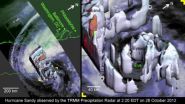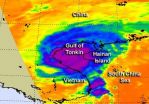(Press-News.org) OAK RIDGE, Tenn., Oct. 29, 2012 — The U.S. Department of Energy's (DOE) Oak Ridge National Laboratory launched a new era of scientific supercomputing today with Titan, a system capable of churning through more than 20,000 trillion calculations each second—or 20 petaflops—by employing a family of processors called graphic processing units first created for computer gaming. Titan will be 10 times more powerful than ORNL's last world-leading system, Jaguar, while overcoming power and space limitations inherent in the previous generation of high-performance computers.
Titan, which is supported by the Department of Energy, will provide unprecedented computing power for research in energy, climate change, efficient engines, materials and other disciplines and pave the way for a wide range of achievements in science and technology.
The Cray XK7 system contains 18,688 nodes, with each holding a 16-core AMD Opteron 6274 processor and an NVIDIA Tesla K20 graphics processing unit (GPU) accelerator. Titan also has more than 700 terabytes of memory. The combination of central processing units, the traditional foundation of high-performance computers, and more recent GPUs will allow Titan to occupy the same space as its Jaguar predecessor while using only marginally more electricity.
"One challenge in supercomputers today is power consumption," said Jeff Nichols, associate laboratory director for computing and computational sciences. "Combining GPUs and CPUs in a single system requires less power than CPUs alone and is a responsible move toward lowering our carbon footprint. Titan will provide unprecedented computing power for research in energy, climate change, materials and other disciplines to enable scientific leadership."
Because they handle hundreds of calculations simultaneously, GPUs can go through many more than CPUs in a given time. By relying on its 299,008 CPU cores to guide simulations and allowing its new NVIDIA GPUs to do the heavy lifting, Titan will enable researchers to run scientific calculations with greater speed and accuracy.
"Titan will allow scientists to simulate physical systems more realistically and in far greater detail," said James Hack, director of ORNL's National Center for Computational Sciences. "The improvements in simulation fidelity will accelerate progress in a wide range of research areas such as alternative energy and energy efficiency, the identification and development of novel and useful materials and the opportunity for more advanced climate projections."
Titan will be open to select projects while ORNL and Cray work through the process for final system acceptance. The lion's share of access to Titan in the coming year will come from the Department of Energy's Innovative and Novel Computational Impact on Theory and Experiment program, better known as INCITE.
Researchers have been preparing for Titan and its hybrid architecture for the past two years, with many ready to make the most of the system on day one. Among the flagship scientific applications on Titan:
Materials Science
The magnetic properties of materials hold the key to major advances in technology. The application WL-LSMS provides a nanoscale analysis of important materials such as steels, iron-nickel alloys and advanced permanent magnets that will help drive future electric motors and generators. Titan will allow researchers to improve the calculations of a material's magnetic states as they vary by temperature.
"The order-of-magnitude increase in computational power available with Titan will allow us to investigate even more realistic models with better accuracy," noted ORNL researcher and WL-LSMS developer Markus Eisenbach.
Combustion
The S3D application models the underlying turbulent combustion of fuels in an internal combustion engine. This line of research is critical to the American energy economy, given that three-quarters of the fossil fuel used in the United States goes to powering cars and trucks, which produce one-quarter of the country's greenhouse gases.
Titan will allow researchers to model large-molecule hydrocarbon fuels such as the gasoline surrogate isooctane; commercially important oxygenated alcohols such as ethanol and butanol; and biofuel surrogates that blend methyl butanoate, methyl decanoate and n-heptane.
"In particular, these simulations will enable us to understand the complexities associated with strong coupling between fuel chemistry and turbulence at low preignition temperatures," noted team member Jacqueline Chen of Sandia National Laboratories. "These complexities pose challenges, but also opportunities, as the strong sensitivities to both the fuel chemistry and to the fluid flows provide multiple control options which may lead to the design of a high-efficiency, low-emission, optimally combined engine-fuel system."
Nuclear Energy
Nuclear researchers use the Denovo application to, among other things, model the behavior of neutrons in a nuclear power reactor. America's aging nuclear power plants provide about a fifth of the country's electricity, and Denovo will help them extend their operating lives while ensuring safety. Titan will allow Denovo to simulate a fuel rod through one round of use in a reactor core in 13 hours; this job took 60 hours on the Jaguar system.
Climate Change
The Community Atmosphere Model–Spectral Element simulates long-term global climate. Improved atmospheric modeling under Titan will help researchers better understand future air quality as well as the effect of particles suspended in the air.
Using a grid of 14-kilometer cells, the new system will be able to simulate from one to five years per day of computing time, up from the three months or so that Jaguar was able to churn through in a day.
"As scientists are asked to answer not only whether the climate is changing but where and how, the workload for global climate models must grow dramatically," noted CAM-SE team member Kate Evans of ORNL. "Titan will help us address the complexity that will be required in such models."
INFORMATION:
ORNL is managed by UT-Battelle for the Department of Energy. The Department of Energy is the single largest supporter of basic research in the physical sciences in the United States, and is working to address some of the most pressing challenges of our time. For more information, please visit http://science.energy.gov.
For Titan images and videos, please visit http://www.olcf.ornl.gov/titan/.
Image: http://www.ornl.gov/info/press_releases/photos/Titan_2012-P03156_3000.jpg
Caption: Oak Ridge National Laboratory is home to Titan, the world's most powerful supercomputer for open science with a theoretical peak performance exceeding 20 petaflops (quadrillion calculations per second). That kind of computational capability—almost unimaginable—is on par with each of the world's 7 billion people being able to carry out 3 million calculations per second.
NOTE TO EDITORS: You may read other press releases from Oak Ridge National Laboratory or learn more about the lab at http://www.ornl.gov/news. Additional information about ORNL is available at the sites below:
Twitter - http://twitter.com/oakridgelabnews
RSS Feeds - http://www.ornl.gov/ornlhome/rss_feeds.shtml
Flickr - http://www.flickr.com/photos/oakridgelab
YouTube - http://www.youtube.com/user/OakRidgeNationalLab
LinkedIn - http://www.linkedin.com/companies/oak-ridge-national-laboratory
Facebook - http://www.facebook.com/Oak.Ridge.National.Laboratory
ORNL debuts Titan supercomputer
Supercomputer combines gaming and traditional computing technologies to provide unprecedented power for research
2012-10-30
ELSE PRESS RELEASES FROM THIS DATE:
NASA's TRMM satellite analyzes Hurricane Sandy in 3-D
2012-10-30
NASA's Tropical Rainfall Measuring Mission, or TRMM satellite can measure rainfall rates and cloud heights in tropical cyclones, and was used to create an image to look into Hurricane Sandy on Oct. 28, 2012. Owen Kelly of NASA's Goddard Space Flight Center in Greenbelt, Md. created this image of Hurricane Sandy using TRMM data.
At 2:20 p.m. EDT on Sunday, Oct. 28, Hurricane Sandy was a marginal category 1 hurricane and its eyewall is modest, as TRMM reveals, which gives forecasters and scientists hints about its possible future strength.
The eyewall appeared somewhat ...
Prostate cancer prognosis hope
2012-10-30
Scientists have discovered a molecular 'tell' in laboratory experiments that could help doctors determine the severity of a patient's prostate cancer.
Cancer of the prostate – the most common male cancer in the UK – presents in two distinct ways: a low-risk type, which may never cause any symptoms, and a high-risk form that needs treatment to prevent it spreading to other parts of the body.
Knowing which type of prostate cancer each patient has – some 40,000 British men per year – is therefore essential to ensuring they receive the correct treatment.
Lead researcher ...
Radiation treatment after surgery improves survival for elderly women with early-stage breast cancer
2012-10-30
BOSTON, Mass. – Oct. 29, 2012. Elderly women with early-stage breast cancer live longer with radiation therapy and surgery compared with surgery alone, researchers at the University of Maryland School of Medicine have found. The researchers, who collected data on almost 30,000 women, ages 70 to 84, with early, highly treatable breast cancer enrolled in a nationwide cancer registry, are reporting their findings at the 54th annual meeting of the American Society for Radiation Oncology (ASTRO).
"Overall survival and breast cancer-specific survival were significantly better ...
Research: Pay satisfaction key driver of work-family conflict
2012-10-30
CHAMPAIGN, Ill. — Employees who are more satisfied with their pay report lower levels of work-family conflict, a study by a University of Illinois labor and employment relations professor shows.
A worker's actual salary is as important as pay satisfaction in determining a worker's happiness, according to the research by professor Amit Kramer.
"Pay, as you might expect, is a relative thing," Kramer said. "I think most people would agree that a certain level of pay that allows you to meet your needs is critical. However, beyond that level, relative pay becomes an issue ...
University of Texas at Austin study measures methane emissions released from natural gas production
2012-10-30
A research team led by The University of Texas at Austin, and including engineering and environmental testing firms URS and Aerodyne Research, is conducting a major field study to measure methane emissions from natural gas production, about which little empirical data exist. With a goal of obtaining scientifically rigorous, representative data from multiple producing basins, the study brings together Environmental Defense Fund (EDF), the university and nine of the nation's leading natural gas producers: Anadarko Petroleum Corporation, BG Group plc, Chevron, Encana Oil & ...
NASA sees Tropical Storm Son-Tinh fill the Gulf of Tonkin
2012-10-30
Tropical Storm Son-tinh made landfall in northern Vietnam is and is curving to the northeast to track over southern China. NASA's Aqua satellite revealed powerful thunderstorms around the storm's center before it made landfall and as it filled up the Gulf of Tonkin.
On Oct. 28 at 0553 UTC (2:53 a.m. EDT) the Atmospheric Infrared Sounder (AIRS) instrument aboard NASA's Aqua satellite captured infrared imagery of Tropical Storm Son-tinh that showed a concentration of strong thunderstorms around the storm's center before it made landfall. Son-tinh was located over the Gulf ...
Early autism intervention improves brain responses to social cues
2012-10-30
An autism intervention program that emphasizes social interactions and is designed for children as young as 12 months has been found to improve cognitive skills and brain responses to faces, considered a building block for social skills. The researchers say that the study, which was completed at the University of Washington, is the first to demonstrate that an intensive behavioral intervention can change brain function in toddlers with autism spectrum disorders.
"So much of a toddler's learning involves social interaction, and early intervention that promotes attention ...
NASA examines Hurricane Sandy as it affects the eastern US
2012-10-30
On Monday, Oct. 29, Hurricane Sandy was ravaging the Mid-Atlantic with heavy rains and tropical storm force winds as it closed in for landfall. Earlier, NASA's CloudSat satellite passed over Hurricane Sandy and its radar dissected the storm get a profile or sideways look at the storm. NASA's Aqua satellite provided an infrared view of the cloud tops and NOAA's GOES-13 satellite showed the extent of the storm. The National Hurricane Center reported at 11 a.m. EDT on Oct. 29 that Hurricane Sandy is "expected to bring life-threatening storm surge and coastal hurricane winds ...
Higher-math skills entwined with lower-order magnitude sense
2012-10-30
The ability to learn complex, symbolic math is a uniquely human trait, but it is intricately connected to a primitive sense of magnitude that is shared by many animals, finds a study to be published by the Proceedings of the National Academy of Sciences (PNAS).
"Our results clearly show that uniquely human branches of mathematics interface with an evolutionarily primitive general magnitude system," says lead author Stella Lourenco, a psychologist at Emory University. "We were able to show how variations in both advanced arithmetic and geometry skills specifically correlated ...
Transforming America by redirecting wasted health care dollars
2012-10-30
The respected national Institute of Medicine estimates that $750 billion is lost each year to wasteful or excessive health care spending. This sum includes excess administrative costs, inflated prices, unnecessary services and fraud — dollars that add no value to health and well-being.
If those wasteful costs could be corralled without sacrificing health care quality, how might that money be better spent?
In a study published in the current online edition of the American Journal of Preventive Medicine, Frederick J. Zimmerman, professor and chair of the department ...
LAST 30 PRESS RELEASES:
NTP-enhanced lattice oxygen activation in Ce-Co catalysts for low-temperature soot combustion
Synergistic interface engineering in Cu-Zn-Ce catalysts for efficient CO2 hydrogenation to methanol
COVID-19 leaves a lasting mark on the human brain
Scientists use ultrasound to soften and treat cancer tumors without damaging healthy tissue
Community swimming program for Black youth boosts skills, sense of belonging, study finds
Specific depressive symptoms in midlife linked to increased dementia risk
An ‘illuminating’ design sheds light on cholesterol
Who is more likely to get long COVID?
Study showcases resilience and rapid growth of “living rocks”
Naval Research Lab diver earns Office of Naval Research 2025 Sailor of the Year
New Mayo-led study establishes practical definition for rapidly progressive dementia
Fossil fuel industry’s “climate false solutions” reinforce its power and aggravate environmental injustice
Researchers reveal bias in a widely used measure of algorithm performance
Alcohol causes cancer. A study from IOCB Prague confirms damage to DNA and shows how cells defend against it
Hidden viruses in wastewater treatment may shape public health risks, study finds
Unlock the power of nature: how biomass can transform climate mitigation
Biochar reshapes hidden soil microbes that capture carbon dioxide in farmland
Reducing saturated fat intake shows mortality benefit, but only in high-risk individuals
Manta rays create mobile ecosystems, study finds
Study: Mixed results in using lipoic acid to treat progressive multiple sclerosis
Norbert Holtkamp appointed director of Fermi National Accelerator Laboratory
New agentic AI platform accelerates advanced optics design
Biologists discover neurons use physical signals — not electricity — to stabilize communication
Researchers discover that a hormone can access the brain by hitchhiking
University of Oklahoma researcher awarded funding to pursue AI-powered material design
Exploring how the visual system recovers following injury
Support for parents with infants at pediatric check-ups leads to better reading and math skills in elementary school
Kids’ behavioral health is a growing share of family health costs
Day & night: Cancer disrupts the brain’s natural rhythm
COVID-19 vaccination significantly reduces risk to pregnant women and baby
[Press-News.org] ORNL debuts Titan supercomputerSupercomputer combines gaming and traditional computing technologies to provide unprecedented power for research





